Effect of Wet Expansion Behavior on Polyimide Membrane Diffractive Lens
Abstract
:1. Introduction
2. Results and Discussion
3. Conclusions
Author Contributions
Funding
Conflicts of Interest
References
- Liaw, D.J.; Wang, K.L.; Huang, Y.C.; Lee, K.R.; Lai, J.Y.; Ha, C.S. Advanced polyimide materials: Syntheses, physical properties and applications. Prog. Polym. Sci. 2012, 37, 907–974. [Google Scholar] [CrossRef]
- Atcheson, P.D.; Stewart, C.; Domber, J.; Whiteaker, K.; Cole, J.; Spuhler, P.; Seltzer, A.; Britten, J.A.; Dixit, S.N.; Farmer, B.; et al. MOIRE: Initial demonstration of a transmissive diffractive membrane optic for large light weight optical telescopes. In Proceedings of the SPIE Astronomical Telescopes + Instrumentation—Space Telescopes and Instrumentation 2012: Optical, Infrared, and Millimeter Wave, Amsterdam, The Netherlands, 21 September 2012; Volume 8442, p. 844221. [Google Scholar] [CrossRef]
- Barton, I.M.; Britten, J.A.; Dixit, S.N.; Summers, L.J.; Thomas, I.M.; Rushford, M.C.; Lu, K.; Hyde, R.A.; Perry, M.D. Fabrication of large-aperture lightweight diffractive lenses for use in space. Appl. Opt. 2001, 40, 447–451. [Google Scholar] [CrossRef] [PubMed]
- Domber, J.L.; Atcheson, P.D.; Kommers, J. MOIRE: Ground test bed results for a large membrane telescope. In Proceedings of the Spacecraft Structures Conference, National Harbor, Maryland, 13–17 January 2014. [Google Scholar] [CrossRef]
- Atcheson, P.; Domber, J.; Whiteaker, K.; Britten, J.A.; Dixit, S.N.; Farmer, B. MOIRE: Ground demonstration of a large aperture diffractive transmissive telescope. In Proceedings of the SPIEA Stronomical Telescopes + Instrumentation—Space Telescopes and Instrumentation 2014: Optical, Infrared, and Millimeter Wave, Montréal, QC, Canada, 28 August 2014; Volume 9143, p. 91431W. [Google Scholar] [CrossRef]
- Rahlves, M.; Rezem, M.; Boroz, K.; Schlangen, S.; Reithmeier, E.; Roth, B. Flexible, fast, and low-cost production process for polymer based diffractive optics. Opt. Express 2015, 23, 3614–3622. [Google Scholar] [CrossRef] [PubMed]
- Feltz, J.C. Development of the modulation transfer function and contrast transfer function for discrete systems, particularly charge-coupled devices [also Comment 35(7), 2105-2106 (July 1996)]. Opt. Eng. 1990, 29, 893–905. [Google Scholar] [CrossRef]
- Meinel, A.B.; Meinel, M.P. Large sparse-aperture space optical systems. Opt. Eng. 2002, 41, 1983–1994. [Google Scholar] [CrossRef]
- Britten, J.A.; Dixit, S.N.; DeBruyckere, M.; Steadfast, D.; Hackett, J.; Farmer, B.; Poe, G.; Patrick, B.; Atcheson, P.D.; Domber, J.L.; et al. Large-aperture fast multilevel Fresnel zone lenses in glass and ultrathin polymer films for visible and near-infrared imaging applications. Appl. Opt. 2014, 53, 2312–2316. [Google Scholar] [CrossRef] [PubMed]
- Zhang, Y.; Jiao, J.C.; Wang, B.H.; Jin, J.G.; Su, Y. Transmissive diffractive membrane optic for large aperture lightweight optical telescope. In Proceedings of the International Conference on Optical Instruments and Technology 2015, Beijing, China, 5 August 2015; Volume 9622, p. 96220G. [Google Scholar]
- Margit, F.; Kuhlow, B.; Pawlowski, E. Effect of fabrication errors on multilevel Fresnel zone lenses. Opt. Eng. 1994, 33, 1229–1236. [Google Scholar] [CrossRef]
- Wang, S.; Yang, W.; Wu, S.B. Effect of fabrication errors on binary optical element imaging quality. In Proceedings of the International Symposium on Photoelectronic Detection and Imaging 2013: Micro/Nano Optical Imaging Technologies and Applications, Beijing, China, 23 August 2013; Volume 8911, p. 891100. [Google Scholar] [CrossRef]
- Stern, M.B.; Holz, M.; Medeiros, S.S.; Knowlden, R.E. Fabricating binary optics: Process variables critical to optical efficiency. J. Vac. Sci. Technol. B 1991, 9, 3117–3121. [Google Scholar] [CrossRef]
- Jin, G.F.; Yan, Y.B.; Wu, M.X. Binary Optics; National Defence Industry Press: Beijing, China, 1998; pp. 192–211. (In Chinese) [Google Scholar]
- Wang, R.; Zhang, Z.; Guo, C.; Xue, D.; Zhang, X. Effects of fabrication errors on diffraction efficiency for a diffractive membrane. Chin. Opt. Lett. 2016, 14, 120501. [Google Scholar] [CrossRef]
- Copp, T.; Domber, J.L.; Atcheson, P.D.; Tandy, W.D.; Kommers, J.; Farmer, B. MOIRE: Membrane material property characterizations, testing and lessons learned. In Proceedings of the Spacecraft Structures Conference, National Harbor, Maryland, 13–17 January 2014. [Google Scholar] [CrossRef]
- Low and Zero CTE Polyimides. Available online: http://nexolvematerials.com/nexolve-products/low-and-zero-cte-polyimides (accessed on 10 March 2016).
- Tsukada, Y. Ultra low CTE (0 PPM/C) polyimide film and its potential application. In Proceedings of the 2010 34th IEEE/CPMT International Electronic Manufacturing Technology Symposium (IEMT), Melaka, Malaysia, 30 November–2 December 2010. [Google Scholar] [CrossRef]
- Huang, X.F.; Sheng, D.R.; Cen, K.F.; Zhou, H. Low-cost relative humidity sensor based on thermoplastic polyimide-coated fiber Bragg grating. Sens. Actuators B Chem. 2007, 127, 518–524. [Google Scholar] [CrossRef]
- Zou, D.S.; Wang, D.F. A new type of polyimide capacitive humidity sensor. Instrum. Technol. Sens. 1992, 1, 6–7. (In Chinese) [Google Scholar]
- Matsuguchi, M.; Kuroiwa, T.; Miyagishi, T.; Suzuki, S.; Ogura, T.; Sakaia, Y. Stability and reliability of capacitive type relative humidity sensors using crosslinked polyimide films. Sens. Actuators B 1998, 52, 53–57. [Google Scholar] [CrossRef]
- Blumentritt, B.F. Anisotropy and dimensional stability of polyimide films. Polym. Eng. Sci. 1978, 18, 1216–1219. [Google Scholar] [CrossRef]
- Wang, L.H.; Wu, S.B.; Yang, W. Analysis of stitched fresnel lens segmented mirrors miss-adjustment error. Acta Opt. Sin. 2016, 36, 0712002. (In Chinese) [Google Scholar]
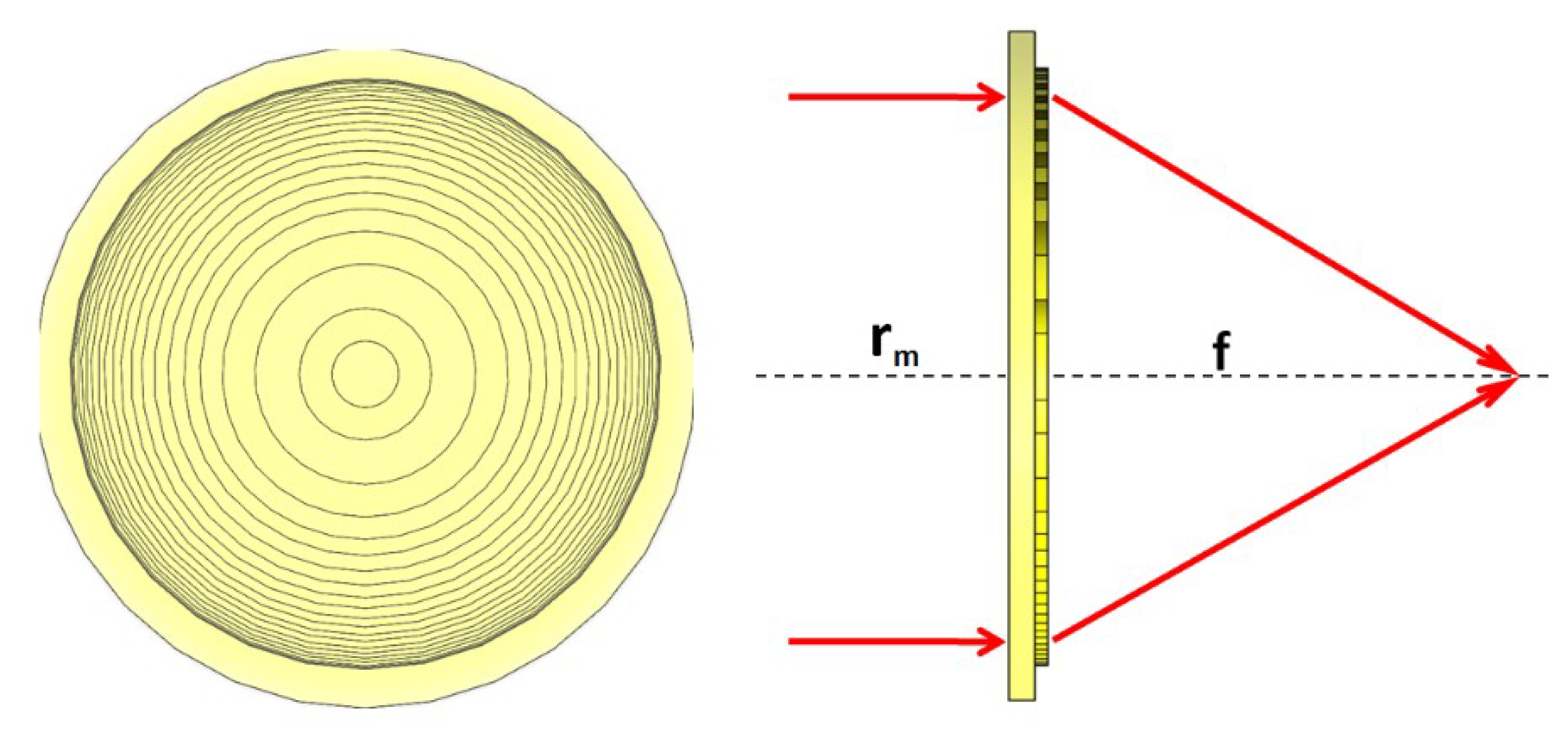
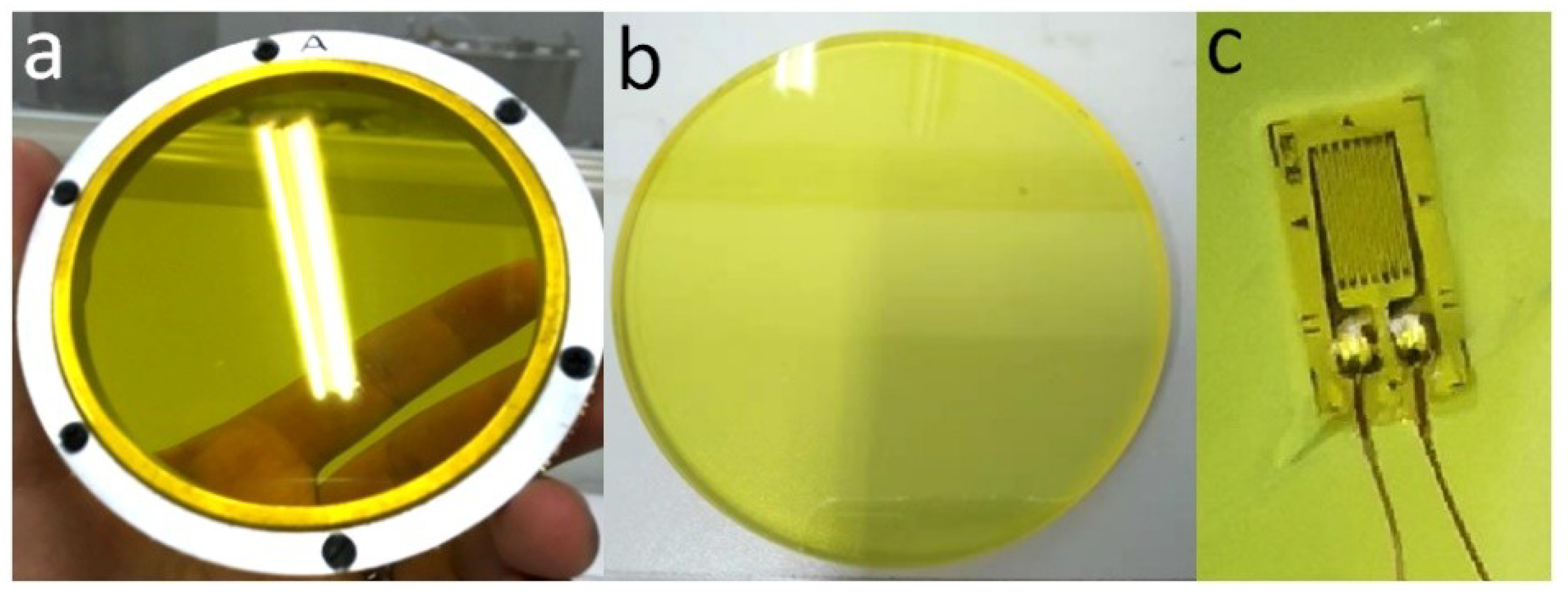
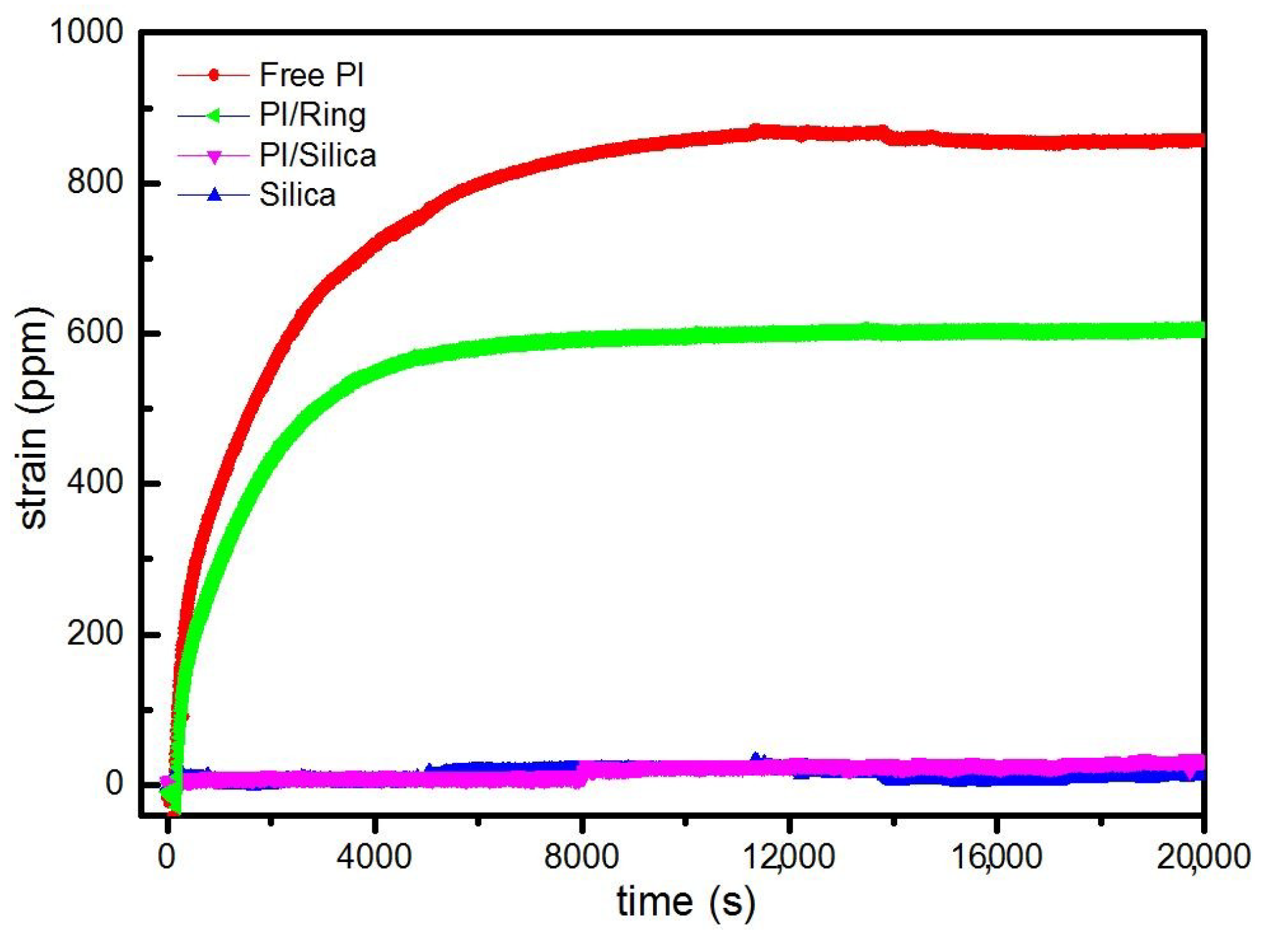
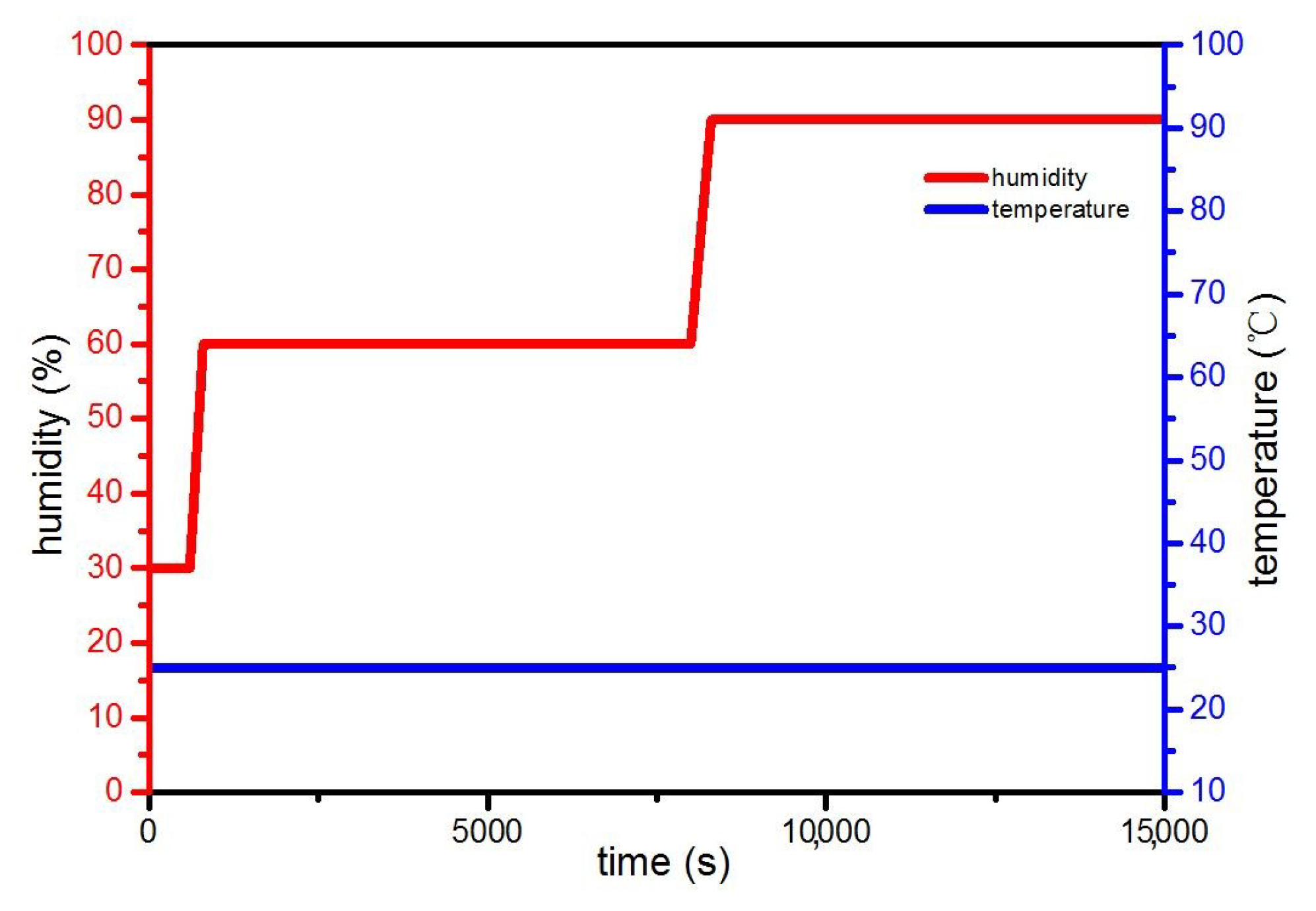

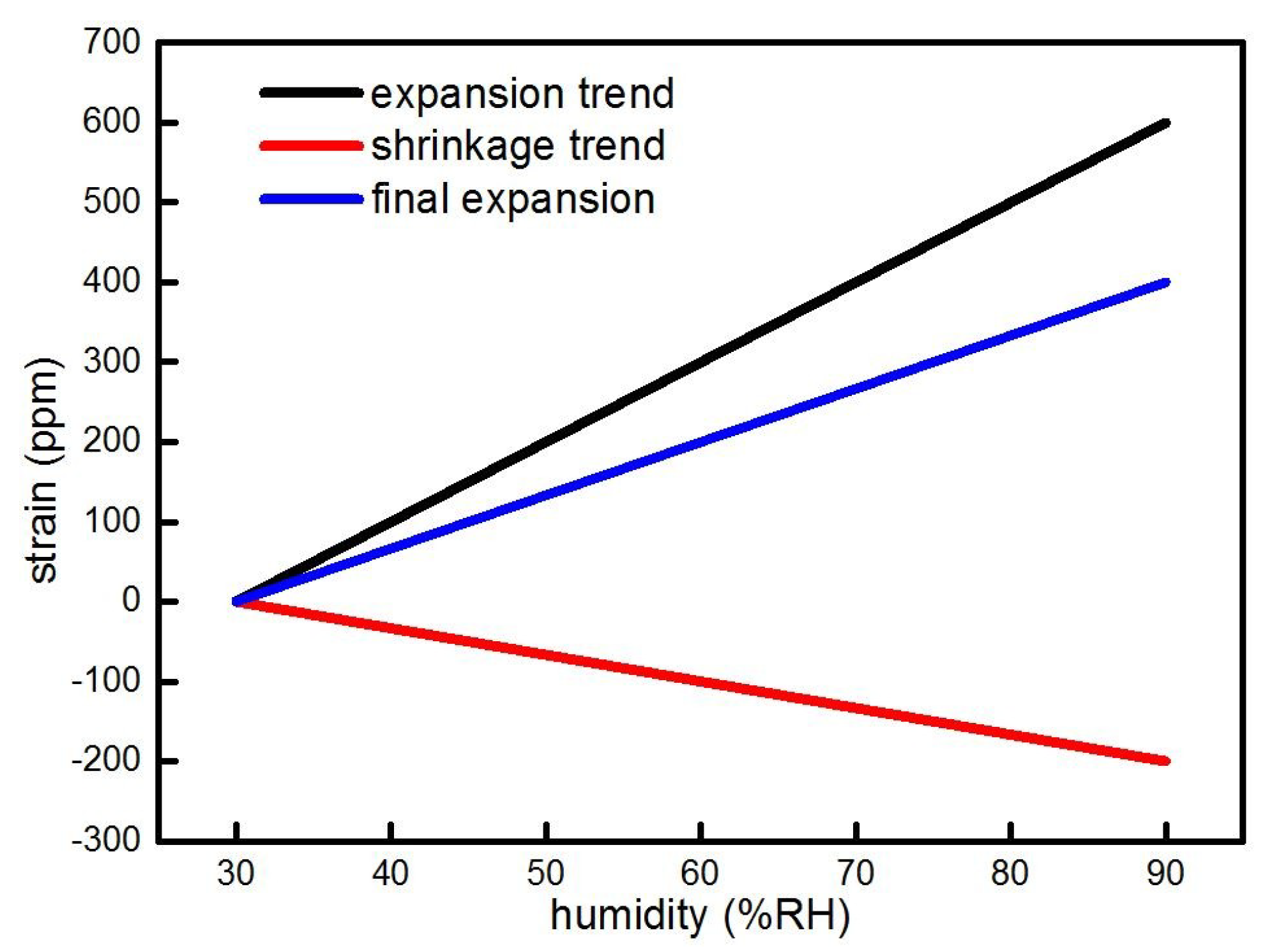
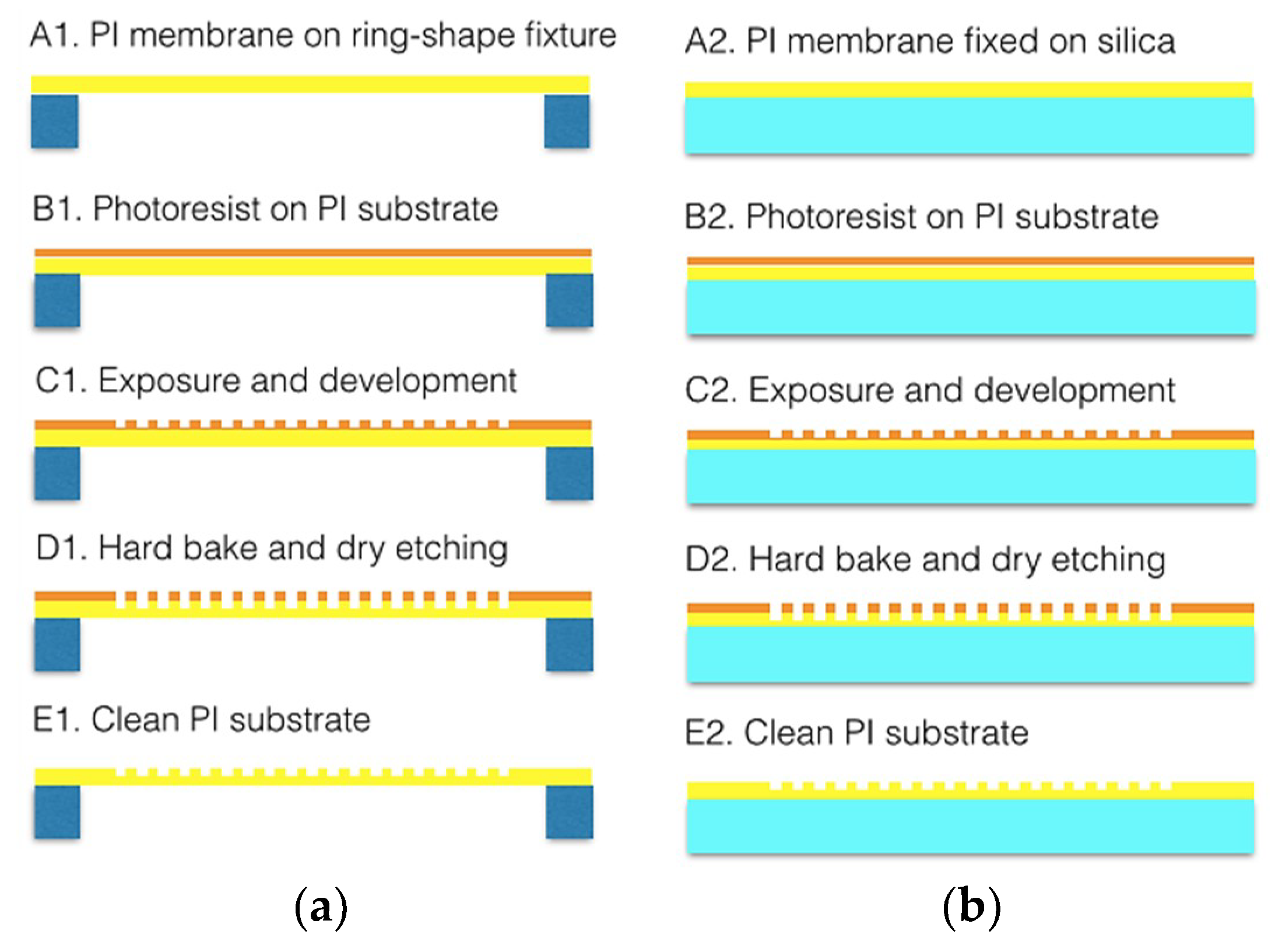

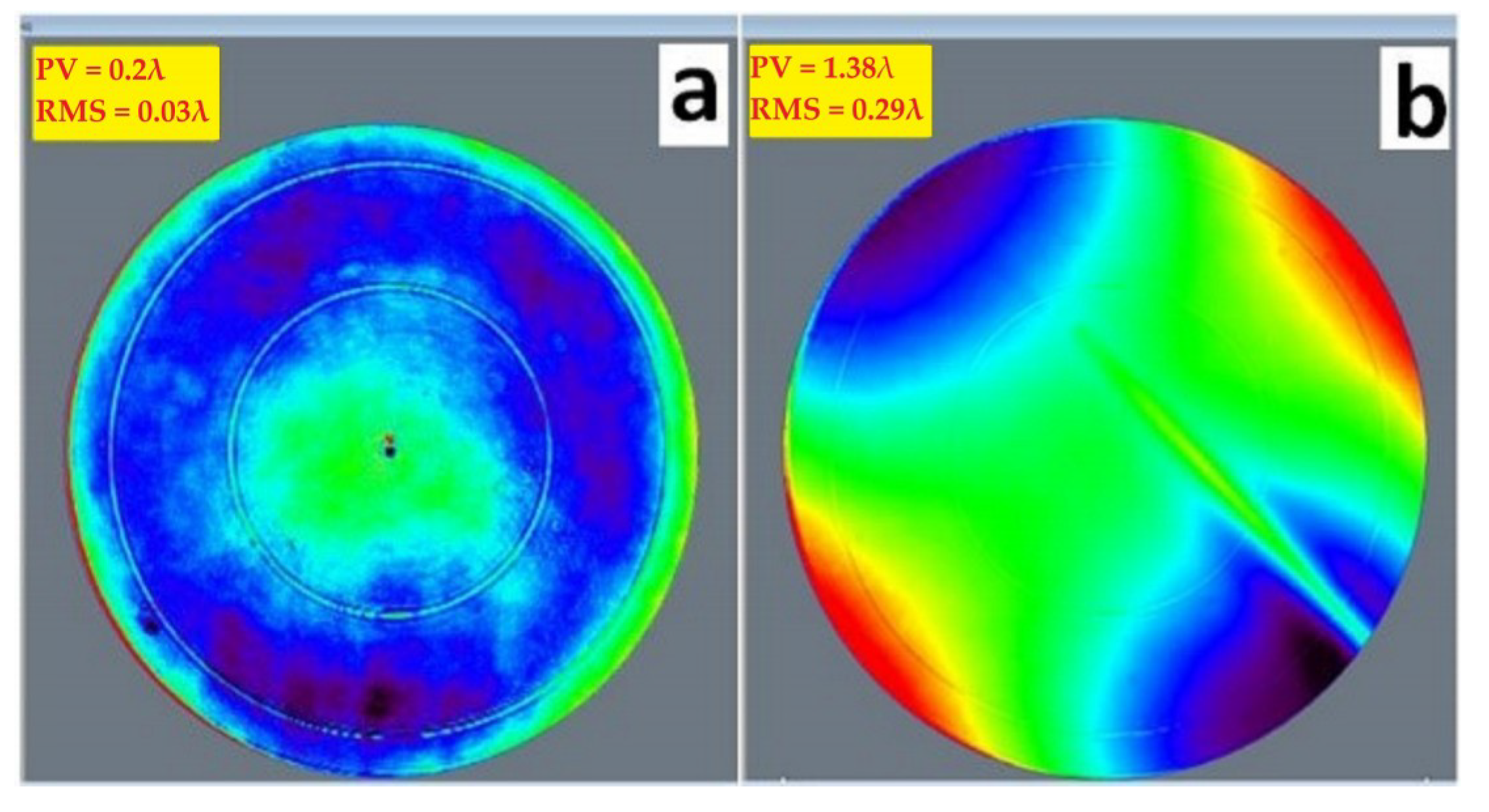
| Process Steps | Parameters | Humidity |
|---|---|---|
| Photoresist | AZ3100, 2000 rpm, 60 s | 40%–60% |
| Soft bake | 100 °C, 5 min | 10%–20% |
| Exposure | 4.5 mW/cm2, 20 s | 40%–60% |
| Development | 5% TMAH, 30 s | 100% |
| Hard bake | 120 °C, 5 min | 10%–20% |
| Dry etching | O2, 30 sccm, 1 Pa, 100 W, 5 min | 0% |
© 2019 by the authors. Licensee MDPI, Basel, Switzerland. This article is an open access article distributed under the terms and conditions of the Creative Commons Attribution (CC BY) license (http://creativecommons.org/licenses/by/4.0/).
Share and Cite
Gao, G.; Mao, D.; Fan, B.; Guan, C. Effect of Wet Expansion Behavior on Polyimide Membrane Diffractive Lens. Coatings 2019, 9, 559. https://doi.org/10.3390/coatings9090559
Gao G, Mao D, Fan B, Guan C. Effect of Wet Expansion Behavior on Polyimide Membrane Diffractive Lens. Coatings. 2019; 9(9):559. https://doi.org/10.3390/coatings9090559
Chicago/Turabian StyleGao, Guohan, Danbo Mao, Bin Fan, and Chunlin Guan. 2019. "Effect of Wet Expansion Behavior on Polyimide Membrane Diffractive Lens" Coatings 9, no. 9: 559. https://doi.org/10.3390/coatings9090559
APA StyleGao, G., Mao, D., Fan, B., & Guan, C. (2019). Effect of Wet Expansion Behavior on Polyimide Membrane Diffractive Lens. Coatings, 9(9), 559. https://doi.org/10.3390/coatings9090559




